Data analytics in life sciences has begun driving smarter decision-making, optimizing operations, and accelerating discoveries. 57.1% of healthcare and life sciences companies now recognize data as a critical asset, while 66.7% credit it as the key driver of innovation.
The impact is clear: 45.5% of companies report transformative business results from data analytics, and AI-driven investments in biopharma have reached $1.5 billion. From streamlining clinical trials to advancing precision medicine, analytics is shaping the future of healthcare.
The global life science analytics market is projected to reach $18.1 billion by 2031. Organizations that harness data effectively will lead the next wave of innovation.
Let’s explore how data analytics shapes life sciences and the key applications driving industry transformation.

What is Data Analytics in Life Sciences?
Data analytics involves collecting, organizing, and analyzing raw data to extract meaningful insights. The life sciences industry uses advanced computational tools, artificial intelligence (AI), and machine learning (ML) to make sense of vast amounts of structured and unstructured data. These insights drive better decision-making, improve operational efficiency, and accelerate research and development (R&D) efforts.
Life sciences organizations deal with enormous datasets, from patient records and clinical trial results to genomic sequences and drug development pipelines. Data analytics processes this complex information using the following:
- Predictive analytics to identify disease trends, forecast patient outcomes, and optimize clinical trials.
- Descriptive analytics to summarize past events and improve reporting for regulatory compliance.
- Prescriptive analytics to guide decision-making in drug development, precision medicine, and patient care.
- AI and machine learning to automate data processing and uncover patterns that may not be visible through traditional analysis.
For example, in clinical trials, data analytics can help pharmaceutical companies identify patient cohorts, reduce trial costs, and speed up drug approval.
By leveraging data analytics, life sciences companies can significantly enhance R&D, improve patient outcomes, and drive industry efficiencies. As AI-driven analytics become more sophisticated, they will play a more significant role in shaping precision medicine, optimizing treatment plans, and ensuring better healthcare delivery.
7 Ways Data Analytics Transform Life Sciences
Data analytics is revolutionizing life sciences, driving informed decision-making, and unlocking new opportunities for innovation. Here are seven key ways it is transforming the industry.
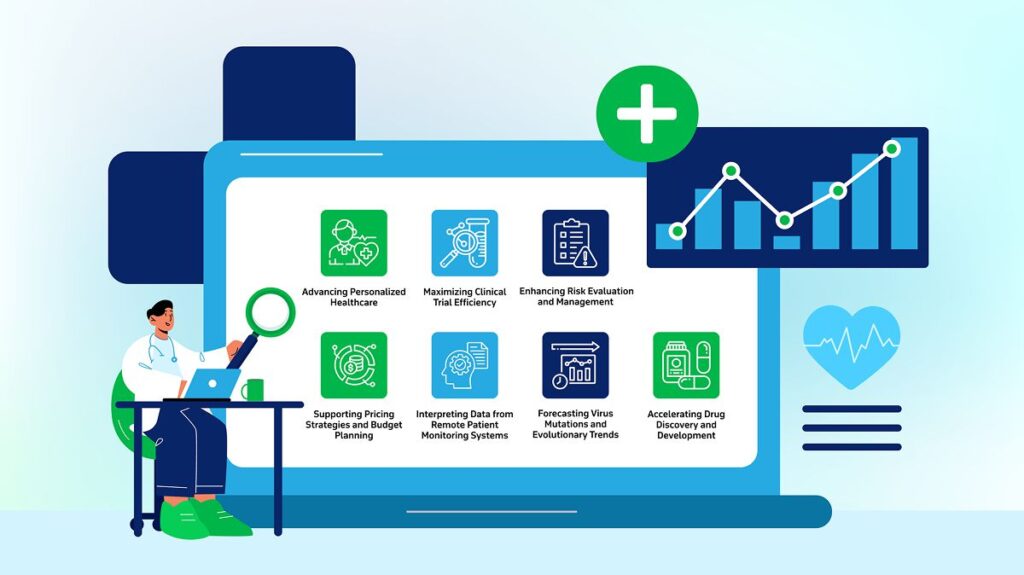
1. Advancing Personalized Healthcare
Personalized medicine tailors treatments to individual patients by analyzing genetic makeup, lifestyle, and medical history, leading to better health outcomes. However, implementing precision medicine requires processing massive amounts of data from sources like genomic sequencing, electronic health records (EHRs), and wearable devices. Traditional methods struggle to manage this complexity, making advanced data analytics essential.
AI-powered analytics tools integrate and analyze multi-omics data, patient records, and digital health inputs to identify patterns, predict treatment responses, and track disease progression. Real-time processing capabilities allow healthcare professionals to develop targeted interventions faster, reducing trial-and-error approaches in medical care.
2. Maximizing Clinical Trial Efficiency
Clinical trials produce vast amounts of data, making it challenging to maintain accuracy and efficiency. Errors, inconsistencies, and misreported events delay drug development and increase costs. Data analytics in life sciences streamlines the process by automating validation, detecting patterns, and optimizing workflows, improving speed and reliability.
Another advantage is more precise patient selection. Analytics tools that use EHRs and medical histories help researchers identify ideal trial participants, reducing dropout rates and enhancing result reliability. Real-time monitoring ensures compliance with regulations while accelerating the drug approval process.
3. Enhancing Risk Evaluation and Management
Risk management is crucial in life sciences, with regulatory bodies like the FDA, EMA, and MHRA enforcing strict safety and efficacy guidelines. Companies must continuously assess potential risks, from clinical trial failures to adverse drug reactions, yet traditional evaluation methods rely on retrospective analysis.
Predictive modeling transforms risk management into a proactive process. By analyzing real-time data, companies can detect regulatory compliance issues, safety concerns, and supply chain disruptions early. This approach helps mitigate risks more effectively, preventing costly recalls and ensuring product integrity.
4. Supporting Pricing Strategies and Budget Planning
Balancing research and development (R&D) costs with competitive pricing models requires data-driven financial planning. Many life sciences companies struggle to justify pricing and forecast profits using traditional methods based only on historical sales data.
Advanced analytics provides a clearer picture by analyzing consumer behavior, treatment outcomes, and market trends. Businesses can optimize pricing strategies, allocate resources more efficiently, and defend profit margins with data-backed insights by segmenting target audiences based on healthcare needs rather than demographics.
5. Interpreting Data from Remote Patient Monitoring Systems
The rise of wearable and implantable medical devices generates a continuous stream of patient health data. Analyzing this real-time information presents challenges for healthcare providers, as traditional systems are not designed to efficiently process such large-scale, unstructured data.
Big data analytics in life sciences helps interpret health metrics, detect anomalies, and provide actionable insights for early intervention. AI-driven algorithms identify trends in chronic disease management, alert clinicians to potential risks, and improve remote patient care by enabling faster responses to health changes.
6. Forecasting Virus Mutations and Evolutionary Trends
Identifying and tracking virus mutations is essential for developing effective treatments and vaccines. Traditional methods rely on symptom observation, often detecting viruses only after significantly spreading them.
DNA sequencing and big data analytics enable early detection by analyzing genetic variations and transmission patterns. Machine learning models compare viral strains against genomic databases, predicting potential threats before outbreaks occur. Faster identification allows researchers to develop targeted vaccines, improving global disease preparedness.
7. Accelerating Drug Discovery and Development
Developing new drugs is time-consuming and expensive, requiring extensive research, testing, and regulatory approval. Traditional drug discovery relies on lengthy experimentation, which increases costs and delays treatment availability.
AI-powered analytics speeds up this process by predicting drug interactions, identifying promising compounds, and repurposing existing medications. By analyzing biological datasets, researchers can reduce trial-and-error testing and more efficiently bring life-saving treatments to market.
Data Analytics in Life Sciences: Notable Use Cases
Data analytics revolutionizes life sciences by turning complex data into actionable insights that drive innovation and efficiency. From drug discovery to public health, its impact powerfully reshapes the industry. Consider these key use cases where data is transforming life sciences:
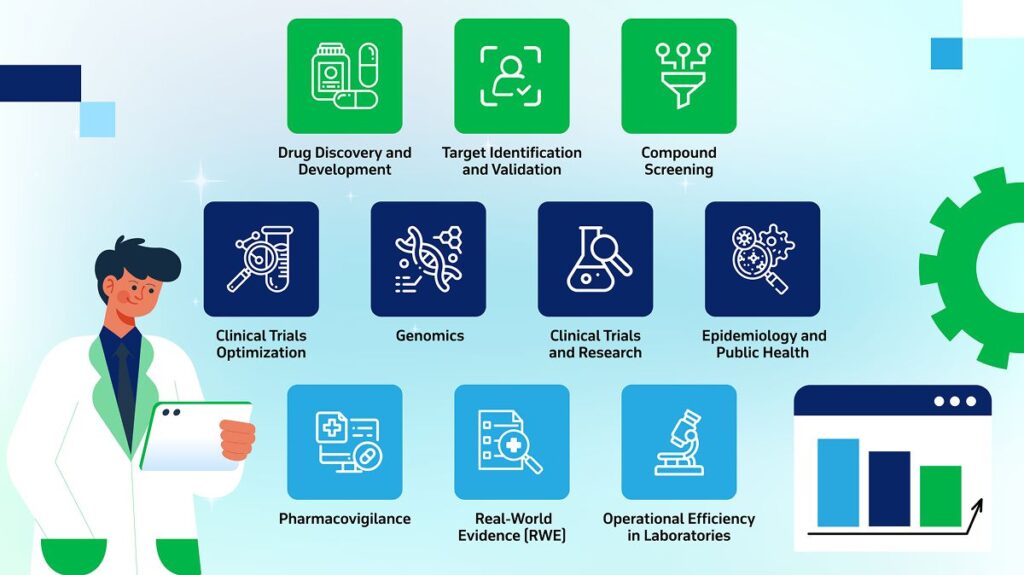
1. Drug Discovery and Development
Bringing life-saving treatments to the market requires extensive research, testing, and regulatory approvals. Data analytics accelerates this process by identifying promising drug candidates faster and more efficiently. By analyzing vast datasets from biological studies, clinical trials, and real-world applications, researchers can streamline drug discovery, reduce development costs, and minimize time to market. AI-driven analytics enhances every stage of drug development, from early-stage discovery to post-market monitoring, improving the likelihood of success.
2. Target Identification and Validation
Pinpointing the correct biological targets is one of the most challenging aspects of drug development. Data analytics in life sciences enables researchers to analyze genetic data and biological pathways to identify biomarkers linked to specific diseases. AI models can process massive datasets to uncover these connections much faster than traditional methods. Using computational models to validate potential targets, pharmaceutical companies can improve efficiency and increase the chances of developing effective therapies while reducing costly trial-and-error research.
3. Compound Screening
Predictive analytics has revolutionized how compounds are screened for drug development. Instead of relying on time-consuming trial-and-error methods, machine learning models analyze chemical properties, historical trial data, and biological interactions to predict a compound’s efficacy and toxicity. This approach allows researchers to narrow down millions of potential compounds to the most promising candidates.
By leveraging big data, pharmaceutical companies can significantly reduce the time and resources spent on early-stage drug development. AI-driven screening techniques provide deeper insights into compound behavior, increasing the likelihood of success in later trial phases. The ability to assess drug viability before physical testing begins leads to better decision-making and cost savings.
4. Clinical Trials Optimization
Designing and conducting clinical trials is an intricate and resource-intensive process. Data analytics in life sciences optimizes trial design by identifying suitable patient populations, predicting potential trial outcomes, and ensuring regulatory compliance. AI models analyze patient demographics, genetic data, and medical histories to match candidates with the correct trials, improving recruitment efficiency and reducing dropout rates. Advanced analytics also enables real-time monitoring of trial progress, flagging anomalies early and ensuring data accuracy. This speeds up drug approval timelines and enhances trial reliability and cost-effectiveness.
5. Genomics
The study of genomics provides insights into how genetic variations influence health and disease. Data analytics helps researchers decode complex genetic data, making identifying patterns and correlations between specific genes and medical conditions easier. Large-scale genomic analysis enables scientists to uncover disease risks, predict treatment responses, and personalize medical interventions.
Whole-genome sequencing, powered by big data, is crucial for early disease detection. Analytics can identify cancer-related mutations, allowing for earlier diagnosis and targeted therapies. The ability to process and analyze vast amounts of genomic data in real-time is revolutionizing precision medicine and paving the way for more effective treatments tailored to individual patients.
6. Clinical Trials and Research
- Patient Recruitment
Finding the right participants for clinical trials is often a significant bottleneck in the research process. Data analytics streamlines recruitment by mining electronic health records (EHRs) to identify patients who meet specific trial criteria. This accelerates recruitment timelines and ensures a more diverse and representative patient population, leading to more reliable trial results.
- Data Monitoring and Management
Real-time data monitoring has transformed clinical trial management. Automated analytics systems detect abnormal patterns in patient data, allowing researchers to intervene promptly when necessary. By continuously tracking trial data, life sciences companies can ensure compliance, improve patient safety, and enhance the overall quality of clinical research.
7. Epidemiology and Public Health
- Disease Surveillance
Data analytics has made it easier to track disease outbreaks and predict public health risks. AI-driven models analyze vast datasets, including social media trends, public health databases, and hospital records, to track the spread of infectious diseases in real-time. This allows public health officials to respond quickly, deploying interventions before outbreaks escalate.
- Population Health Management
Analyzing population health data provides critical insights into healthcare trends, allowing for targeted public health initiatives. AI-powered analytics can identify regions with high rates of chronic diseases, enabling healthcare organizations to allocate resources more effectively. Public health agencies can develop more strategic approaches to disease prevention and management by understanding patterns in disease prevalence and treatment outcomes.
8. Pharmacovigilance
Ensuring drug safety extends beyond the early clinical trials, and data analytics plays a key role in monitoring adverse drug reactions (ADRs) post-market. AI-powered algorithms process patient feedback, EHRs, and pharmaceutical reports to detect early warning signs of drug safety issues. Identifying patterns in reported side effects helps pharmaceutical companies take corrective actions before widespread harm occurs.
Machine learning models continuously scan real-world data to assess drug performance over time. If a medication exhibits unexpected side effects in specific patient groups, data analytics in life sciences helps flag those issues before they escalate into larger public health concerns. This proactive approach protects patients and strengthens regulatory compliance.
9. Real-World Evidence (RWE)
- Post-Market Surveillance
Once a drug reaches the market, ongoing data analysis helps track its long-term effects across diverse patient populations. Researchers can assess drug safety and efficacy in everyday clinical settings by aggregating real-world data from EHRs, insurance claims, and patient registries. Post-market insights enable healthcare providers to make data-informed decisions and adjust treatment guidelines.
- Comparative Effectiveness Research
Comparing treatment outcomes across patient populations allows researchers to determine which medications work best for specific conditions. Using data analytics in life sciences helps evaluate the effectiveness of different drugs by analyzing large-scale patient data, identifying patterns in treatment success rates, and guiding clinical recommendations. Healthcare professionals can tailor therapies to individual needs by leveraging real-world evidence and improving patient outcomes.
10. Operational Efficiency in Laboratories
- Automation and Workflow Optimization
Modern laboratories rely on data analytics to enhance efficiency and streamline processes. Automated systems optimize sample processing, reducing turnaround times and minimizing human error. By integrating machine learning, laboratories can handle high volumes of tests more accurately, ensuring faster and more reliable results.
- Quality Control
Maintaining accuracy in laboratory testing is critical for both research and patient care. Real-time analytics detect deviations in test results, prompting immediate corrective actions when necessary. By continuously monitoring lab performance, data-driven systems help maintain compliance with regulatory standards, improve research integrity, and enhance patient safety.
Equip your team to excel in leveraging these transformative applications of data analytics with our Backlog Acceleration service, designed to streamline and accelerate your integration processes.

Tips for Selecting the Right Data Analytics in Life Sciences Partner
Harnessing the full potential of data analytics in life sciences is easier with the right partner leading the way. To ensure the best fit for your organization, consider these key points when selecting an analytics partner.
1. Understand Your Business Needs
A strong data analytics partner must thoroughly understand your organization’s goals, challenges, and reasons for adopting data analytics. Inexperienced analytics providers may lack the industry-specific knowledge needed to address the unique demands of life sciences. Selecting a partner with healthcare and life sciences expertise ensures they can offer tailored solutions that align with regulatory requirements, clinical workflows, and research-driven analytics, leading to more impactful results.

2. Ensure Scalable Data Processing and Storage
Life sciences organizations generate huge amounts of data, and the volume continues to grow exponentially. A reliable data analytics partner must have the infrastructure to handle large datasets efficiently while offering scalable processing and storage capabilities. Cloud-based platforms, distributed computing, and high-performance analytics tools ensure seamless data management as business needs evolve. Scalability prevents system bottlenecks and enables continuous data-driven insights.
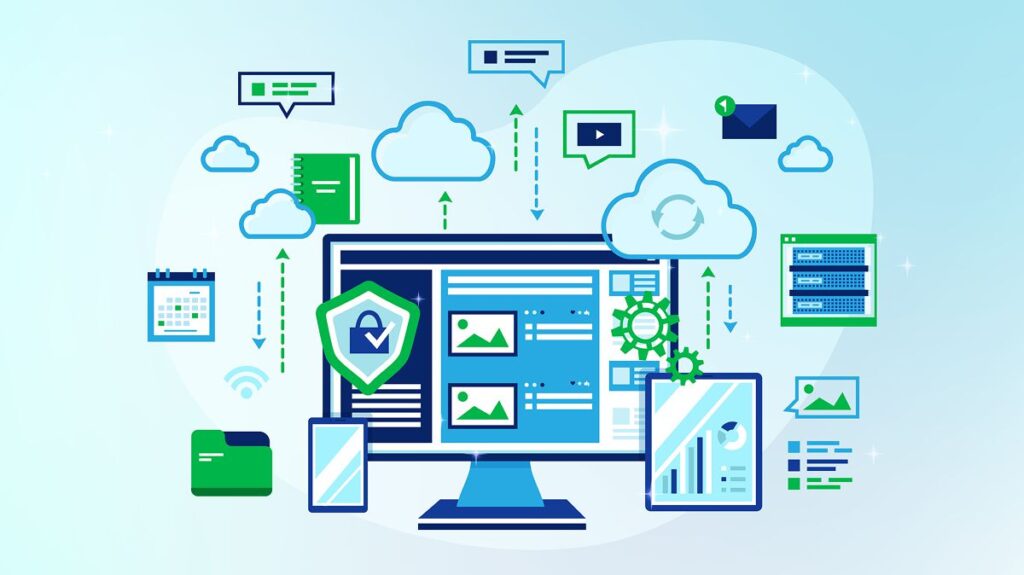
3. Implement Service Level Agreements (SLAs)
Clearly defined SLAs set expectations for service quality, support response times, and system uptime. To minimize disruptions, a strong data analytics partner should commit to issue resolution, disaster recovery, and system reliability. In addition, the contract should allow for renegotiation or termination if SLAs are not met, giving your organization control over performance and ensuring accountability from the vendor.

4. Follow Regulatory Compliance Standards
The life sciences industry operates under strict data security, privacy, and compliance regulations. Depending on your location and operations, your data analytics partner must adhere to HIPAA, GDPR, and FDA guidelines. Ensuring compliance protects sensitive patient data, minimizes legal risks, and strengthens stakeholder trust. Partners should also have robust security measures to safeguard patient information, clinical trial data, and proprietary research.
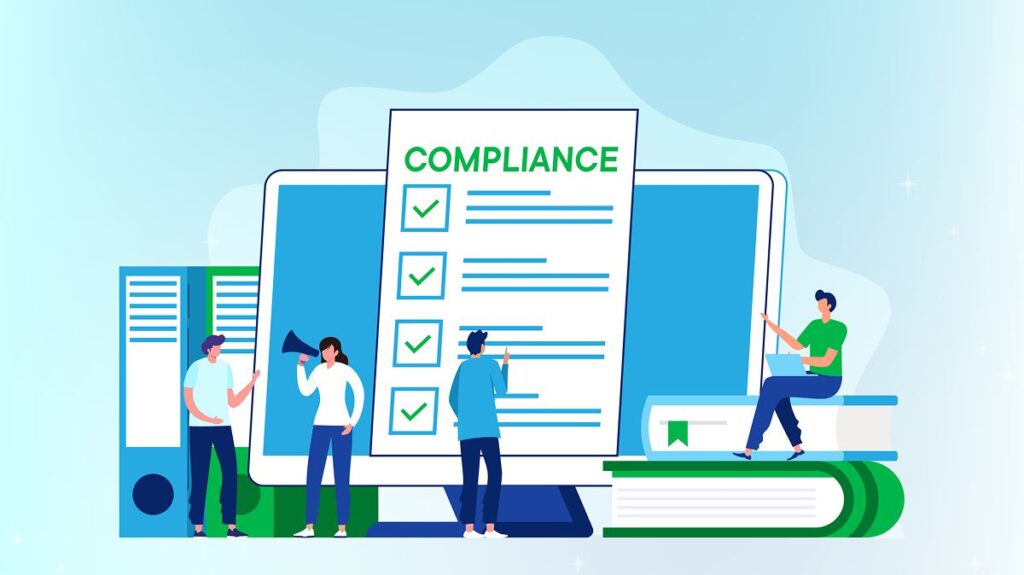
5. Prioritize Experience in HealthTech
Life sciences organizations using advanced analytics tools will be a sum of their parts. They need a partner with hands-on experience in healthcare and medical technology. A vendor with a deep understanding of healthtech can extract meaningful insights from complex datasets, whether from electronic health records (EHRs), clinical trials, or genomic studies. Expertise in AI-driven analytics, predictive modeling, and interoperability with medical systems ensures that the partner can deliver actionable intelligence that drives better decision-making and innovation.
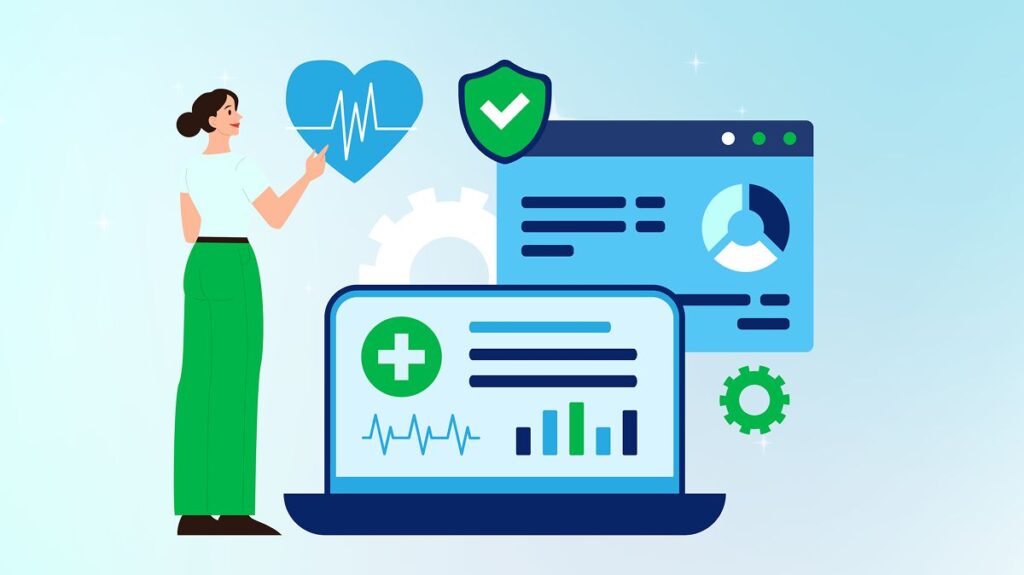
Achieve Data-Driven Success in Life Sciences with KMS Healthcare
As data becomes a critical asset in life sciences, leveraging advanced analytics solutions can unlock powerful insights, streamline operations, and drive innovation. KMS Healthcare delivers tailored BI and data analytics services designed specifically for healthcare and life sciences organizations, including:
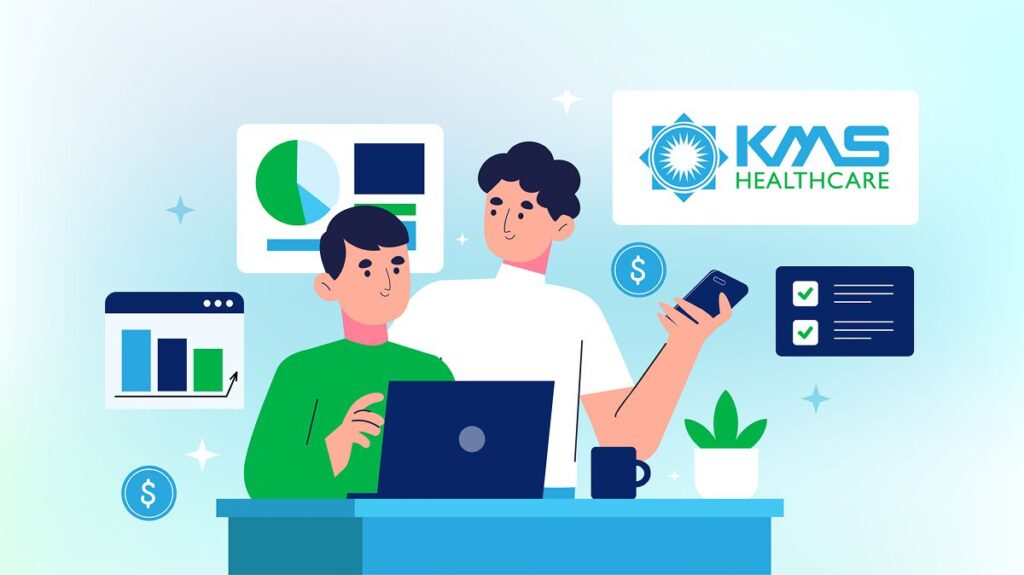
- End-to-End Data Solutions: Transform raw healthcare data into meaningful insights with data engineering, warehousing, visualization, and predictive analytics.
- AI-Driven Insights & Scalable Analytics: Utilize AI, machine learning, and automation to enhance data accuracy, optimize workflows, and improve decision-making.
- Compliance-Ready & Industry-Focused Approach: Ensure regulatory compliance with HIPAA, GDPR, and HITRUST while addressing unique life sciences challenges like clinical data management and real-time reporting.
Looking to unlock the full potential of your data analytics in life sciences? Contact us to explore the right analytics solutions for your needs.